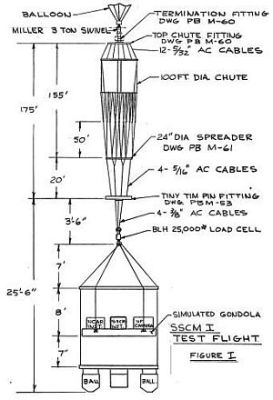Purpose of the flight and payload description
The flight was part of the development of the Small Superconducting Magnet (SSCM) an experiment carried out as part of the High Altitude Particle Physics Experiment (HAPPE), a project originally conceived by scientist Luis W. Alvarez, at the University of California, Berkeley that would use a large superconducting magnet under a stratospheric balloon in order to study extremely high-energy particle interactions.
Prior to the first flight of the full-fledged instrument, the scientific team required that the balloon-parachute-rigging system be certified via a successful test flight using a dummy gondola. At first they contracted the Air Force Cambridge Research Laboratory (AFCRL) to fly the simulated package from its balloon launch station located in Chico, California. However, after three unsuccessful attempts to fly it during December 1969 and January 1970, the contract with AFCRL was cancelled and the task was transfered via another contract to the National Center for Atmospheric Research (NCAR) which at the time operated the balloon launch facility at Palestine, Texas.
Figure at left shows the suspension train used in the test (click to enlarge).
The payload was composed by a simulated gondola that weighted 3600 pounds, carrying onboard an up-looking 16 mm camera and several sensors. The main objective of the test was to obtain a perfect picture of the behaviour and dynamic loads experienced by the gondola when suddenly air-dropped from an altitude of 103,000 feet as would occur at the end of a normal flight. Force data was continuously telemetered from the load cell and acceleration data was telemetered continuously from the sensor mounted atop the dead weight.
Details of the balloon flight
Balloon launched on: 3/23/1970 at 6:58 cst
Launch site: Columbia Scientific Balloon Facility, Palestine, Texas, US
Balloon launched by: NCAR National Scientific Balloon Flight Station
Balloon manufacturer/size/composition: Zero Pressure Balloon Winzen 10.600.000 cuft (1.5 mil. 1.0 mil cap- Stratofilm)
Flight identification number: 536P
End of flight (L for landing time, W for last contact, otherwise termination time): 3/23/1970
Balloon flight duration (F: time at float only, otherwise total flight time in d:days / h:hours or m:minutes - ): F 1 h 55 m
Landing site: In Many, Louisiana, US
Payload weight: 4371 lbs
The balloon was launched by dynamic method from Palestine, Texas on March 23, 1970. After moving to the east the gondola was separated in a point located 150 miles of the launch site for a final landing place in Many, Louisiana.
The scientists obtained valuable data of the shocks experienced by the gondola during cutdown and snatch. Cutdown is the instant of separation, by explosive shear pins, of the balloon from the parachute train while snatch is the sudden deceleration caused by the blossoming of the parachute. Maximum accelerations occured during snatch, and were recorded at 5.5 g's. Also was obtained a film taken automatically during early descent.
External references
- High-altitude Particle Physics and Cosmic-ray Experimental Facility Physics Report, Lawrence Radiation Laboratory, University of California Berkeley, Nov.1960 - Jun. 1970, Pag. 35
- Initial Descent Data - Test Flight Nº 536P Luis Alvarez memos collection at Berkeley Lab. 1970 Pag. 17
- NCAR Scientific Balloon Facility Annual Report, 1970 National Center for Atmospheric Research, February 1971
4503If you consider this website interesting or useful, you can help me to keep it up and running with a small donation to cover the operational costs. Just the equivalent of the price of a cup of coffee helps a lot.


